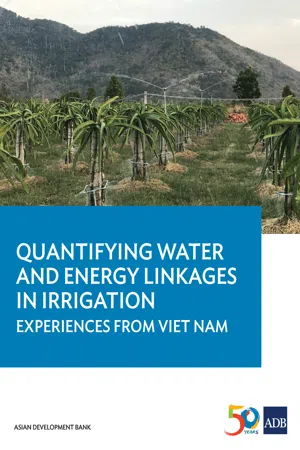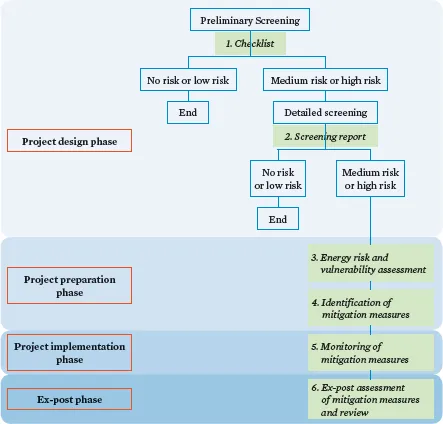
eBook - ePub
Quantifying Water and Energy Linkages in Irrigation
Experiences from Viet Nam
This is a test
Buch teilen
- 52 Seiten
- English
- ePUB (handyfreundlich)
- Über iOS und Android verfügbar
eBook - ePub
Quantifying Water and Energy Linkages in Irrigation
Experiences from Viet Nam
Angaben zum Buch
Buchvorschau
Inhaltsverzeichnis
Quellenangaben
Über dieses Buch
While Asia has the world's fastest-growing economy, 29 of 48 countries assessed by the Asian Water Development Outlook are water-insecure, posing a threat to the region's continued growth. As economies develop, increasing demands will be placed on water for food and water for energy. In the irrigation subsector, energy is required for ground and surface water pumping, as well as for fueling on-farm irrigation technology and other farm machinery. Water and energy are intrinsically linked, yet there is limited information on quantifying energy use in irrigation systems. This publication summarizes the results of a pilot study to quantify water and energy use in high-efficiency irrigation systems within drought-affected provinces in Viet Nam.
Häufig gestellte Fragen
Wie kann ich mein Abo kündigen?
Gehe einfach zum Kontobereich in den Einstellungen und klicke auf „Abo kündigen“ – ganz einfach. Nachdem du gekündigt hast, bleibt deine Mitgliedschaft für den verbleibenden Abozeitraum, den du bereits bezahlt hast, aktiv. Mehr Informationen hier.
(Wie) Kann ich Bücher herunterladen?
Derzeit stehen all unsere auf Mobilgeräte reagierenden ePub-Bücher zum Download über die App zur Verfügung. Die meisten unserer PDFs stehen ebenfalls zum Download bereit; wir arbeiten daran, auch die übrigen PDFs zum Download anzubieten, bei denen dies aktuell noch nicht möglich ist. Weitere Informationen hier.
Welcher Unterschied besteht bei den Preisen zwischen den Aboplänen?
Mit beiden Aboplänen erhältst du vollen Zugang zur Bibliothek und allen Funktionen von Perlego. Die einzigen Unterschiede bestehen im Preis und dem Abozeitraum: Mit dem Jahresabo sparst du auf 12 Monate gerechnet im Vergleich zum Monatsabo rund 30 %.
Was ist Perlego?
Wir sind ein Online-Abodienst für Lehrbücher, bei dem du für weniger als den Preis eines einzelnen Buches pro Monat Zugang zu einer ganzen Online-Bibliothek erhältst. Mit über 1 Million Büchern zu über 1.000 verschiedenen Themen haben wir bestimmt alles, was du brauchst! Weitere Informationen hier.
Unterstützt Perlego Text-zu-Sprache?
Achte auf das Symbol zum Vorlesen in deinem nächsten Buch, um zu sehen, ob du es dir auch anhören kannst. Bei diesem Tool wird dir Text laut vorgelesen, wobei der Text beim Vorlesen auch grafisch hervorgehoben wird. Du kannst das Vorlesen jederzeit anhalten, beschleunigen und verlangsamen. Weitere Informationen hier.
Ist Quantifying Water and Energy Linkages in Irrigation als Online-PDF/ePub verfügbar?
Ja, du hast Zugang zu Quantifying Water and Energy Linkages in Irrigation von im PDF- und/oder ePub-Format sowie zu anderen beliebten Büchern aus Technik & Maschinenbau & Umweltmanagement. Aus unserem Katalog stehen dir über 1 Million Bücher zur Verfügung.
Information
Thema
Umweltmanagement1
Introduction
Water and energy are intrinsically linked. Almost all energy generation processes require significant amounts of water. The most straightforward water-related process is hydroelectricity generation, providing 16% of electricity globally, 14% in East Asia and the Pacific and 13% in South Asia (World Bank 2014, 2013 estimates). Biofuels and coal are also well-known water guzzlers; and fracking has joined the list more recently. Water requirements per unit of fossil-fuel based electricity generation are particularly high at 75 cubic meters per megawatt hour (m3/MWh) to 450 m3/MWh. Similarly, most water supply activities require large amounts of energy with ranges from 0.4 kilowatt-hour per cubic meter (kWh/m3) to about 8.3 kWh/m3 to provide safe water for humans from rivers, lakes, or seawater, for example. This includes water treatment up to a standard so that it can be used for drinking or other purposes as well as treating sewage water and effluents before releasing such waters back into water bodies.
Another important use is the pumping of large amounts of water for irrigation—worldwide approximately 40% of irrigated areas depend on groundwater, for example. South Asia alone accounts for half of all groundwater used globally. Agriculture uses the bulk of withdrawn freshwater consumed globally, about 85%, and more in developing countries and the Asia region, such as South Asia, which consumed 91% in 2013 (World Bank 2014).
With growing pressures on water resources, there is a push to reduce water use per unit of crop produced. While there are many ways to increase water use efficiency or productivity, a key avenue is through the installation of High-Efficiency Irrigation Systems (HEIS). Globally, one-fifth of all irrigated area are now under some form of HEIS (Table 1). HEIS shares are largest in Europe and the Americas. Shares are much lower in Asia, but are increasing in the region. However, HEIS generally uses more energy than traditional surface irrigation as a large share of surface systems are still gravity-fed.
Table 1: Net Irrigated Area and Share of High-Efficiency Irrigation Systems

HEIS = high-efficiency irrigation system, mha = million hectares.
Source: International Commission on Irrigation and Drainage. 2015. Annual Report 2015–2016. http://www.icid.org/ar_2014.pdf
As economies develop, increasing demands will be placed on water for food and water for energy. In Asia, primary energy production is expected to double and power generation to more than triple by 2050. The increased demand for energy will put additional pressure on already constrained water resources. Estimates for Asia predict a 65% increase in industrial water use, 30% increase in domestic use, and a 5% increase in agriculture use by 2030 (World Bank 2013). This illustrates the growing and acute competition among principal water users. In the irrigation subsector, energy use is primarily for ground or surface water pumping and use of petroleum for on-farm irrigation technologies and other farm machinery. Energy is also used in the production of agricultural chemicals. Continued expansion of groundwater use, its impact on water tables, the growing demand for energy and the cost to the power sector are highly relevant for Asia where energy prices often do not reflect the true cost of supply.
The Asian Development Bank (ADB) has supported the Pilot and Demonstration Field-Based Research: Quantifying Water and Energy Links in Irrigation for Improved Resource Utilization in Viet Nam to identify linkages between irrigation and energy use. The study is associated with the ongoing project preparatory technical assistance for the Water Efficiency Improvement in Drought Affected Provinces (WEIDAP) in Viet Nam. The overall goal of this pilot and demonstration activity (PDA) is to improve the understanding of water and energy productivity in the operational context and increase water and energy efficiency in irrigated agriculture. The main objectives of the PDA are:
(i)Development of an Energy Use Checklist to assess energy use in irrigation systems.
(ii)Application of the checklist in two planned irrigation investments to identify linkages between HEIS and improved water and energy productivity: (a) the Du Du irrigation scheme, served by the Tan Thanh Irrigation Canal in Ham Thuan Nam district, Bin Thuan Province; and (b) the proposed pumped irrigation from the Krong Buk Ha reservoir in Dak Lak Province.
(iii)Identification of elements of a business model for HEIS (cost-sharing measures adopted, role of private sector, uptake today).
2
Energy Checklist for Irrigation Projects
The energy checklist was developed to guide ADB project officers and other stakeholders who work on irrigation design, development, or modernization on how to assess the energy use in irrigation systems. The checklist includes three major components: (i) energy access of the site in question; (ii) information on energy linkages to the specific irrigation project; and (iii) environmental impacts like greenhouse gas emissions (Appendix, Table 1). To get feedback on the checklist, it was presented at a Water–Energy–Food Nexus workshop that was held at the International Food Policy Research Institute (IFPRI) headquarters in Washington, DC. in July 2016. The draft checklist was also shared with the Irrigation Listserve for feedback as well as with selected experts at ADB.
The following comments were received from the Irrigation Listserve and then incorporated into an updated list:
(i)Differentiate between river basin and irrigation system issues.
(ii)Distinguish between hydropower upstream, from the same source reservoir, and within the system (turbining canal water, for example).
(iii)Identify issues related to not just water sharing/supply but also operation. Timing of hydropower generation may generate significant perturbations to canal irrigation supplies service that tend to propagate chaos throughout system deliveries, and need to be managed.
(iv)Clarify, for pumping, official/public pumping versus pumping done privately by farmers. A project objective may try and decrease farmers’ energy costs by providing improved surface service (at a lower cost).
(v)Sensors are not necessarily associated with high-efficiency irrigation but may have to do with Supervisory Control and Data Acquisition or automation, i.e., operation.
(vi)Include pollution considerations due to the higher energy cost in water treatment.
(vii)Consider the possibility of using crop residues on irrigated fields for energy generation.
(viii)Clarify if irrigation is needed and what are environmental flow requirements and potential competition at the basin level.
(ix)Identify the share of renewable energy sources for electricity generation.
The implementation of the energy checklist could follow a framework and sequence similar to that of ADB’s Climate Risk Management (Figure 1). As such, it would include different steps at different time phases of the project cycle, with the checklist (focus of this activity) used during the project design stage. If the project were deemed to not be at risk regarding energy use or dependency, then it would proceed as usual; if a medium or high risk or dependence on energy were identified, then a screening report would be developed. During the project preparation phase, if the activity would still be considered medium or high risk, an energy risk and vulnerability assessment would be implemented that would include energy-related mitigation measures. During project implementation, these measures and indicators would need to be monitored, and after project completion, insights from the analysis and monitoring would feed back into future project design and preparation.
Figure 1: Process for Energy–Irrigation monitoring along the project cycle

Source: ADB.
The checklist was applied to the two study sites in the central highlands of Viet Nam. Based on the checklist, key energy-related differences for the two project areas relate to the type of intervention—Binh Thuan focused on upgrading of a canal system (Binh Thuan) and Dak Lak focused on reservoir-serviced irrigation. Other energy-related differences relate to the cropping pattern (dragon fruit versus coffee). Based on the draft documents on the case study sites, it was not possible, however, to fill in all sections of the energy checklist conclusively. For example, it remained unclear if the ADB suggested interventions and investments would substitute fully for ongoing groundwater based irrigation.
3
Links between High-Efficiency Irrigation and Water and Energy Productivity
A. Overview on Study Sites and Main Activities Linking Energy with Irrigation
To improve knowledge of energy and water use in irrigation activities in Viet Nam, two sites that form part of the Water Efficiency Improvement in Drought Affected Provinces (WEIDAP) project in Viet Nam were examined. WEIDAP aims to improve irrigation water use efficiency for high value crops in the most severely drought-affected provinces of the South Central Coastal and Central Highland Regions. The potential irrigation subprojects to be upgraded are located in Khanh Hoa, Ninh Thuan, Binh Thuan, Dak Nong, and Dak Lak provinces. The proposed project will undertake institutional strengthening of irrigation agencies to improve system management, upgrade irrigation infrastructure and introduce high-efficiency irrigation systems. Among these provinces, Binh Thuan and Dak Lak were selected, specifically the Du Du–Tan Thanh Irrigation Canal and various small reservoirs in Dak Lak Province (Figure 2).
Figure 2: Study Sites in Dak lak and Binh Thuan provinces

Source: ADB.
The Dak Lak subpro...